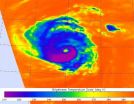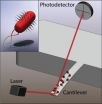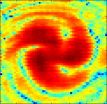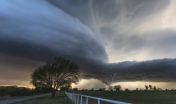(Press-News.org) The unmanned Global Hawk aircraft that's part of NASA's airborne Hurricane and Severe Storm Sentinel, or HS3 mission was winging its way to Hurricane Edouard on September 16. In addition to the Global Hawk, various NASA satellites are continually providing data on the Atlantic hurricane.
Scientific instruments aboard NASA's remotely piloted Global Hawk aircraft have been studying the hurricane over the last couple of days, and the Global Hawk returned to Edouard again today, September 16. Two of the instruments aboard the Global Hawk that will study Edouard are the S-HIS and CPL. The S-HIS or Scanning High-resolution Interferometer Sounder will provide continuous sampling of temperature and relative humidity in the clear-air environment, while the CPL or Cloud Physics Lidar will study the aerosols (tiny particles) and the vertical structure of the cloud layers of the hurricane.
"Hopefully Edouard will maintain a clear eye so that S-HIS and CPL can get a good look down into it," said Scott Braun, Principal Investigator of the HS3 mission of NASA's Goddard Space Flight Center in Greenbelt, Maryland. In addition to the S-HIS and CPL, the Advanced Vertical Atmospheric Profiling System (AVAPS) will drop sondes into the hurricane that will measure temperature, humidity and full tropospheric wind (winds in every level of the troposphere from top to bottom as the sonde falls).
On September 15 at 12:47 p.m. EDT when NASA's Aqua satellite passed over the Central Atlantic, several instruments that fly aboard captured information about the storm in visible and infrared light. The Moderate Resolution Imaging Spectroradiometer or MODIS instrument aboard captured a visible image of Hurricane Edouard revealing thick bands of thunderstorms spiraling into a clear eye.
At the same time, The Atmospheric Infrared Sounder or AIRS instrument aboard analyzed those bands of thunderstorms in infrared light. Infrared light tells temperature of the cloud tops and surrounding sea surface. AIRS revealed that some of the cloud top temperatures in the band of tightly wound thunderstorms around Edouard's center were near 220 kelvin (-63F/-53C) indicating that they were high in the troposphere, and powerful. NASA research has shown that storms with cloud tops that high and cold have the potential to drop heavy rainfall. Forecaster Berg at the National Hurricane Center noted at 5 a.m. EDT on September 16 that "Convective (thunderstorm) cloud tops within Edouard's eyewall have occasionally been as cold as about -75C, but the eye has actually cooled during the past few hours."
On September 16 at 0614 UTC (2:14 a.m. EDT) NASA's Tropical Rainfall Measuring Mission or TRMM satellite also flew over Edouard and showed that the hurricane's eyewall is partially open on the north side, which means it is exposed to outside winds that can weaken it.
At 5 a.m. EDT Hurricane Edouard's maximum sustained winds were near 110 mph (175 kph)and some slight strengthening is possible over the next day, according to the National Hurricane Center. The hurricane is about 465 miles (765 km) east-southeast of Bermuda, and is moving to the north-northwest at 13 mph (20 kph), however it is expected to turn to the north followed by a turn northeast on September 17.
Edouard is expected to strengthen over the next day before weaken quickly due to colder water and increasing vertical wind shear.
INFORMATION:
The HS3 mission is funded by NASA Headquarters and overseen by NASA's Earth System Science Pathfinder Program at NASA's Langley Research Center in Hampton, Virginia. It is one of five large airborne campaigns operating under the Earth Venture program.
Rob Gutro
NASA's Goddard Space Flight Center
NASA's Global Hawk and satellites investigating Hurricane Edouard today
2014-09-16
ELSE PRESS RELEASES FROM THIS DATE:
Cancer patients with malignant spinal cord compression have preserved mobility
2014-09-16
San Francisco, September 15, 2014—Mobility is equally preserved in cancer patients suffering from malignant spinal cord compression (MSCC) who receive a single dose of 10 Gy of radiation therapy (RT), compared to patients who receive five daily doses of 4 Gy of RT each, according to research presented today at the American Society for Radiation Oncology's (ASTRO's) 56th Annual Meeting.
Malignant spinal cord compression (MSCC) is a complication of metastatic cancer mostly with bone involvement that occurs when a tumor's secondary deposit presses on the spinal cord and ...
And so they beat on, flagella against the cantilever
2014-09-16
WASHINGTON D.C., September 16, 2014 – A team of researchers at Boston University and Stanford University School of Medicine has developed a new model to study the motion patterns of bacteria in real time and to determine how these motions relate to communication within a bacterial colony.
The researchers chemically attached colonies of Escherichia coli bacteria to a microcantilever – a microscopic beam anchored at one end, similar to a diving board – thus coupling its motion to that of the bacteria. As the cantilever itself isn't doesn't generate any vibrations, or 'noise,' ...
NASA sees Tropical Storm Odile knocking at US Southwest
2014-09-16
Tropical Storm Odile continues to drench western Mexico and has now entered into the U.S. Southwest. On September 15, NASA's Terra satellite saw Odile's northernmost edge crossing the Mexican border into southern California. NOAA's GOES-East satellite on September 16 showed Odile's outer bands were already bringing storms to southern Arizona.
NASA Sees Odile Knocking on U.S. Border
On Sept. 15 at 2:35 p.m. EDT, the Moderate Resolution Imaging Spectroradiometer instrument aboard NASA's Terra satellite saw the northern fringes of Hurricane Odile straddling the border ...
Scientists twist radio beams to send data
2014-09-16
Building on previous research that twisted light to send data at unheard-of speeds, scientists at USC have developed a similar technique with radiowaves, reaching high speeds without some of the hassles that can go with optical systems.
The researchers, led by electrical engineering professor Alan Willner of the USC Viterbi School of Engineering, reached data transmission rates of 32 gigabits per second across 2.5 meters of free space in a basement lab at USC.
For reference, 32 gigabits per second is fast enough to transmit more than 10 hour-and-a-half-long HD movies ...
Kessler Foundation scientists link slowed processing speed with executive deficits in MS
2014-09-16
West Orange, NJ. September 16, 2014. Kessler Foundation researchers have published a study supporting the role of slowed processing speed in the executive deficits found in individuals with multiple sclerosis (MS). "Does slowed processing speed account for executive deficits in multiple sclerosis? Evidence from neuropsychological performance and structural neuroimaging," was published online ahead of print on August 18 by Rehabilitation Psychology The authors are Victoria Leavitt, PhD, of the Manhattan Memory Center, formerly of Kessler Foundation. Co-authors are Foundation ...
Tornadoes occurring earlier in 'Tornado Alley'
2014-09-16
WASHINGTON, D.C. – Peak tornado activity in the central and southern Great Plains of the United States is occurring up to two weeks earlier than it did half a century ago, according to a new study whose findings could help states in "Tornado Alley" better prepare for these violent storms.
Tornado records from Nebraska, Kansas, Oklahoma, and northern Texas – an area of high tornado activity dubbed "Tornado Alley" -- show that peak tornado activity is starting and ending earlier than it did 60 years ago.
Peak tornado activity, which occurs in the region from early ...
Water-based nuclear battery developed by MU can be used to generate electrical energy
2014-09-16
COLUMBIA, Mo. – From cell phones to cars and flashlights, batteries play an important role in everyday life. Scientists and technology companies constantly are seeking ways to improve battery life and efficiency. Now, for the first time using a water-based solution, researchers at the University of Missouri have created a long-lasting and more efficient nuclear battery that could be used for many applications such as a reliable energy source in automobiles and also in complicated applications such as space flight.
"Betavoltaics, a battery technology that generates power ...
Patients waiting too long to see doctor? Try 'just-in-time' management methods, researchers urge
2014-09-16
Using a pain clinic as a testing ground, researchers at Johns Hopkins have shown that a management process first popularized by Toyota in Japan can substantially reduce patient wait times and possibly improve the teaching of interns and residents.
In a report on the pilot study, published online Sept. 9, in Pain Medicine, the researchers adopted the so-called "Just-in-Time" training and inventory process used now by many manufacturers and service industries to stem waste and keep complicated operations from bottlenecking.
"We realized that a significant amount of time ...
Study on global carbon cycle may require reappraisal of climate events in Earth's history
2014-09-16
MIAMI – A recent study of the global carbon cycle offers a new perspective of Earth's climate records through time. Scientists at the University of Miami (UM) Rosenstiel School of Marine and Atmospheric Science suggest that one of the current methods for interpreting ancient changes in the concentration of carbon dioxide in the atmosphere and oceans may need to be re-evaluated.
The UM Rosenstiel School researchers measured the abundance of carbon-12 and carbon-13 isotopes in both the organic matter and carbonate sediments found in a nearly 700-meter marine sediment core ...
UCI team is first to capture motion of single molecule in real time
2014-09-16
Irvine, Calif., Sept. 16, 2014 – UC Irvine chemists have scored a scientific first: capturing moving images of a single molecule as it vibrates, or "breathes," and shifts from one quantum state to another.
The groundbreaking achievement, led by Ara Apkarian, professor of chemistry, and Eric Potma, associate professor of chemistry, opens a window into the strange realm of quantum mechanics – where nanoscopic bits of matter seemingly defy the logic of classical physics.
This could lead to a wide variety of important applications, including lightning-fast quantum computers ...








